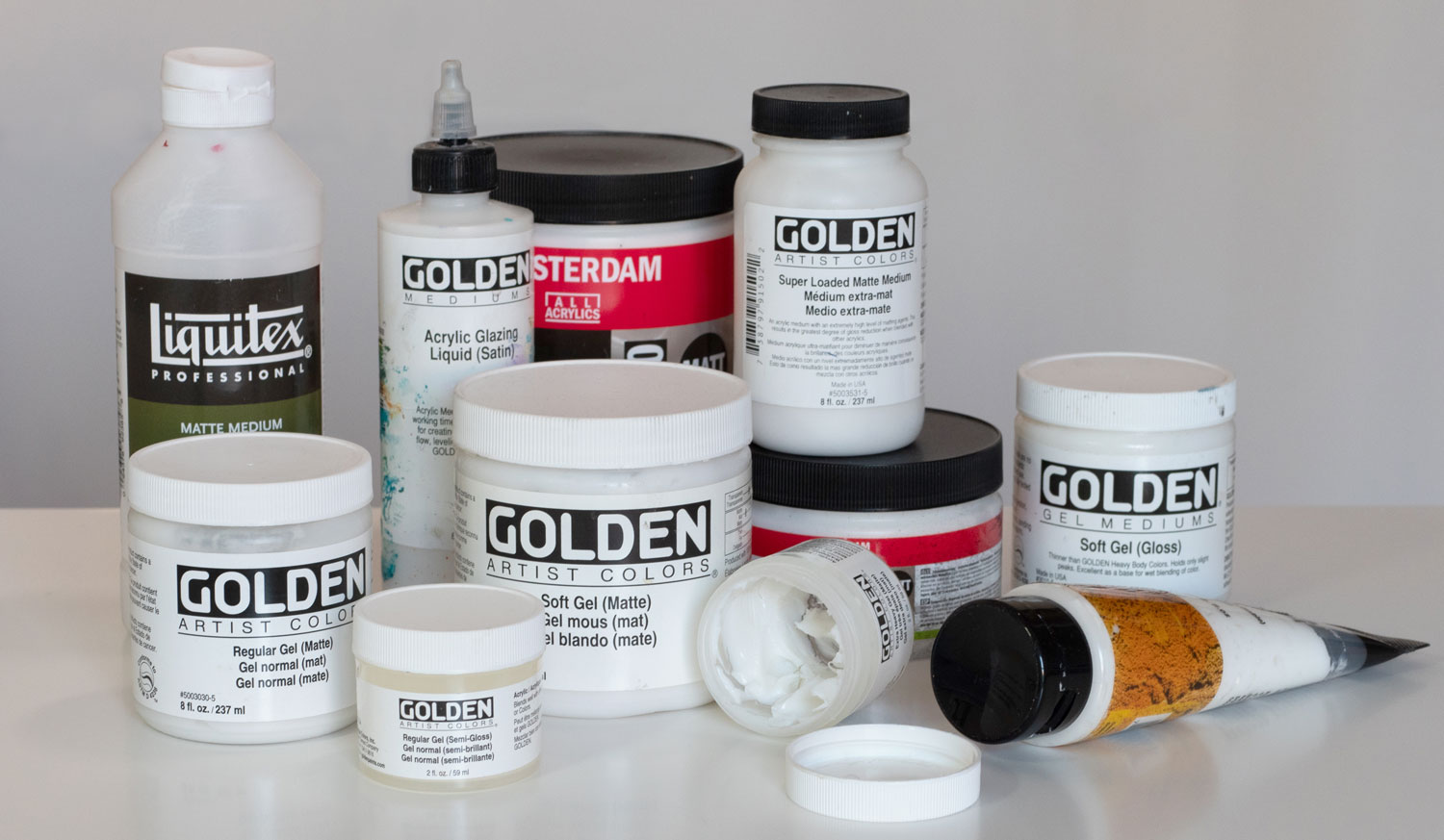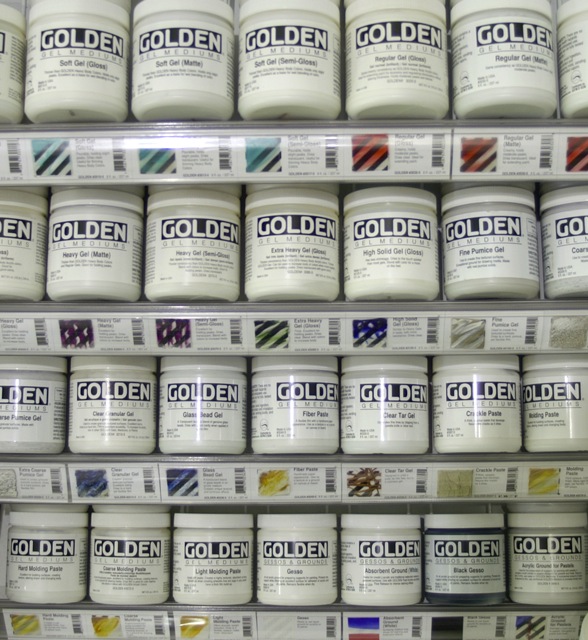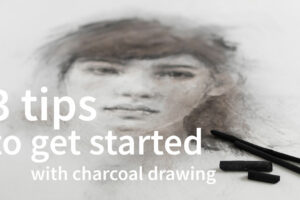
Gloss gel medium, matte medium, heavy gel, pouring medium… If you’ve worked with acrylic paint for some time you’ve probably heard these terms before. Maybe you also have some of these products in your stash.
But what are acrylic gels and mediums exactly? What are the differences between the various products, and what can they be used for?
In my in-depth mixed media class Drawing in the Soul we’ll be working with these products as well, so it’s good to know more about this topic. So let’s delve into the world of acrylic gels and mediums!
Acrylic paint is a relatively modern type of paint, first sold commercially in the 1950s. It’s made of pigment suspended in acrylic polymer emulsion. Acrylic paint is a fast drying paint, which means that you can quickly add new layers on top of each other and continue painting. It’s water-based, which means that you can clean your brushes and tools with water instead of having to use solvents. But when the paint dries it becomes water-resistant.
Now, if you ever went to a fine art store and looked around in the acrylic paint section, you have probably noticed that there are lots of products which can be used in combination with acrylic paints. These products change the properties of the paint, in different ways and for various purposes. Roughly these products fall into the following categories:
- Acrylic gels and mediums
- Translucent acrylic polymers which alter the properties of acrylic paint
- Examples: matte medium, extra heavy gloss gel
- Additives
- Other products (with or without acrylic polymers) which alter the properties of acrylic paint
- Examples: retarders, flow extenders, glazing liquid
- Pastes
- Opaque acrylic polymers which can be used to alter the properties of acrylic paint or to create a surface for acrylic paint
- Examples: molding paste (also called modeling paste), crackle paste, fiber paste
In this article we’re going to have a closer look at this first category: acrylic mediums and gels. I’ll discuss what they are, the differences between them, and the purposes they can be used for. I’ll cover additives and pastes in a future article.
What are acrylic gels and mediums?
Simply put: you can think of acrylic gels and mediums as acrylic paint without the pigment. So they are like a colorless paint. They consist of the same polymer emulsion that is the binder that holds the pigment of acrylic paint.
What are the main differences between gels and mediums?
The main differences between gels and mediums are the viscosity and the sheen. Those are also important for their practical use, which I’ll discuss further below. But first let’s have a look at viscosity and sheen.
1. Viscosity
The first difference between mediums and gels is their viscosity. This means how thick or thin the product is. Mediums are thin, liquid, and can be poured. Gels on the other hand have a buttery or even thicker consistency.
The pure polymer emulsion that is the basis of mediums and gels (and also of acrylic paint), is liquid. So in order to create thicker mediums and gels, the manufacturer adds a thickener to them. The thicker the product, the more thickening agent is being added.
Now, there is a bit of a confusion sometimes in the terminology. The whole range of these products, whether fluid or of a thicker consistency, are all ‘acrylic mediums’. A ‘medium’ in this context is a product that can change the properties of the paint. So if we want to be really accurate, the liquid types should be called ‘fluid mediums’ and the thicker types should be called ‘gel mediums’. However, in practice the fluid types are often just called ‘mediums’ and the thicker types are called ‘gels’.
Different brands have slightly different names for these products, but in general you can range the mediums and gels in the following way from most fluid to most thick:
- Airbrush medium
- Polymer medium / Fluid medium (or just: medium)
- Soft gel
- Regular gel
- Heavy gel
- Extra heavy gel
2. Sheen
Acrylic gels and mediums come in a variety of sheens or reflectiveness. The most ‘pure’ or regular type is gloss. That is because the polymer emulsion which is the base of the mediums and gels, has a glossy sheen of itself. However, you can also buy mediums and gels in matte varieties. Those types have extra ingredients added to them which make the product matte. Sometimes you can also find ‘satin’ or ‘semi-gloss’ mediums or gels. Those have a sheen that looks a bit like wax or satin: in between gloss and matte.
So now you know that when someone refers to ‘matte medium’, they mean a liquid acrylic medium which has matting agents added to it so it doesn’t have any glossy sheen. Or when you hear mentioning about ‘heavy gloss gel, they mean that it’s a thick acrylic medium which has no matting agents, so it has a glossy sheen.
Now, regardless of the sheen, all gels and mediums look a kind of milky white when you apply them. But when they are dry they become clear, translucent. The matte varieties of mediums and gels are a bit less translucent than the gloss products, since they have a matting agent added to them. But they are all still quite translucent.

What are gels and mediums used for?
Acrylic gels and mediums can be used for various purposes, such as:
- Changing consistency of acrylic paint
- Changing sheen of acrylic paint
- Increasing transparency of acrylic paint
- Adhesive (glue)
- Texture
- Surface treatment
Let’s have a closer look at these different purposes.
1. Changing the consistency of acrylic paint
As I’ve mentioned above, all gels and mediums are essentially acrylic paint without the color. But one of the main differences between the gels and mediums is their viscosity or thickness. So this property can be used to change the consistency of acrylic paint.
The reason is that acrylic paint comes in a variety of thicknesses. You can buy fluid paints, soft body paints, heavy body paints, and so on. So if you have a certain paint and you want to change its thickness, you can use a gel or medium to do that. So if you want to make a fluid paint thicker, you can add some gel to it. Or if you want to make a heavy body paint thinner, you can add some medium to it.
2. Changing the sheen of acrylic paint
Different types, brands, and series of acrylic paints can have different sheens. Some are more glossy, others are more matte. So if you have a glossy paint and you want to make it more matte, you can add a matte medium or matte gel to reduce the sheen.
Sometimes (especially with more expensive artist grade paints) there can even be differences within the same series of paints. So for example an ultramarine blue color of a specific series of paint from a specific brand can be more glossy than a cadmium red of that same series of paint from that same brand. If you have used these colors in the same painting, you can get different sheens within that same painting, which you might not want. In that case, when you’re finished painting you can add a coat of medium in the sheen that you want (gloss, matte) and cover your whole painting so the sheen is uniform over the whole painting.
3. Increasing the transparency of acrylic paint
As I mentioned above, all gels and mediums are milky-white when you apply them, but they dry translucent. So if you want to make your paint more translucent, you can add a bit of medium or gel to it. It takes a bit of experience to learn how to work with this property, since the white color of the wet medium or gel makes the paint color initially a bit lighter, but changes to a translucent color when it dries. But with time you’ll learn how to work with these properties.
This translucent property is also the reason that acrylic paint is sold in different thicknesses, such as fluid, soft body, or heavy body. As I mentioned above, you can change the consistency of acrylic paint by adding a medium or gel to it, to make it thinner or thicker. However, this also means that the paint becomes more translucent. The more medium gel is being added, the more translucent your paint becomes. If you want to keep the opacity of the paint but want to change its viscosity (thickness), then it’s best not to add gel or medium but purchase the paint in the thickness (or fluidness) that you want.
4. Adhesive (glue)
Acrylic mediums and gels have very good adhesive qualities and can therefore be used as great adhesives or glues. You can use them as ‘standalone’ glue, or to combine it with acrylic paint (for instance if you want to glue something to a painting, or if you want to paint over something you’ve glued).
One example of this purpose is to use acrylic mediums or gels for paper collage. You can use liquid mediums to glue down thinner types of papers, like tissue paper or printer paper. For thicker paper like cardstock it’s best to use a gel medium, since it’s stronger and can hold thicker papers better.
Another way to use the adhesive qualities of gels and mediums, is for image or photo transfers. This is a technique where you transfer the ink of a printed image or photo onto a different surface, such as a canvas. The acrylic medium or gel will act as the transfer agent which adheres the ink (and sometimes part of the paper as well) to the surface.
5. Texture
The viscosity properties of gels and mediums can also be used to create texture. You can for instance use a gel to create impasto effects, or to work with a palette knife. You can mix the gel with paint to give it a certain color, or you can apply the gel directly to the surface (and paint over it if you like).
Another example of using mediums and especially gels for texture, is to add other ingredients to it. Artists use all kinds of products for this purpose, such as sawdust, eggshells, sand, and so on. There are also various ready-made specialty gels available that have extra ingredients added to create texture. Examples are glass bead gel, pumice gel, granular gel, mica flake gel, and more.
6. Surface treatment
The last purpose of acrylic gels and mediums that I want to discuss here, is for surface treatment.
You can use for example a gloss medium to seal a surface, in order to make it water-resistant or to protect the layers beneath. This will also make the surface fairly smooth, which can be used for instance to create special resist effects, or to create a smooth base to add glazes to.
Another example of a surface treatment is when you have painted with acrylic paint and want to draw with colored pencils or pastel pencils on top of it. Unless you use a very matte acrylic paint, the surface will usually be too slick for pencils. You need a bit of a rough texture (tooth) in order to draw with pencils. In that case you can apply a layer of matte fluid medium over the paint. The matting agents in the medium create a bit of a gritty surface, which is more suited for drawing.
So this was an introduction to acrylic gels and mediums. There’s a whole world that opens up if you start working with these products! I personally have a variety of mediums and gels, but I mostly use matte medium, regular & soft gel, and glazing liquid. And what about you? Do you use mediums and/or gels? Which ones, and for what purpose? Is there a purpose of gels and mediums that I didn’t mention in this article? I’d love to hear from you!
Foundational portrait course
If you would like to learn all about creating portraits, then my foundational portrait course Drawing in the Soul is for you.
In this in-depth online class we take a deep dive in fundamental art concepts like tonal value, line and color. You'll learn how to draw the facial proportions in various directions, and work with a host of different mediums and supplies: from acrylic paint to charcoal, pastel, collage, and more.
This class is suited for all levels: from complete beginners to more experienced artists. We'll start from the very basics and build up to more advanced levels.






Best explanation of these items, I had purchased some and then managed to forget what they were for… LOL .. thank you so much!
Thank you for all the great info!
Question: I recently purchased a set of stencils that I really love. When they arrived I realized that they were made of cardstock rather than plastic. Bummer! Before returning them, I would like to try to just waterproof them (or at least make them water-resistant and more sturdy). Would coating them with medium or gesso make them more viable for use with acrylics for gel printing?
Hi Cindy, that’s a bummer indeed! Acrylic medium or gesso can certainly help to make the cardstock more water-resistand, but it also bonds to acrylic paint, rather than being resisted by it. However, whether or not you can use it for your cardstock stencils also depends on how you are going to use the stencils when you’re gel printing. If you don’t apply the stencil for a long time to the paint it could work, but I’m not sure and is definitely something you need to just try out and experiment with. Let me know how it goes!
What type of medium would you suggest for an image transfer onto metal? This would be for a piece of jewelry. Thank you!
This is a great article that clearly explains the different terms and types of additives.
I was searching for your next two articles on additives and paste, but I don’t see them?
thank you very much.
Thanks so much Grace! Unfortunately I haven’t been able to write the other article yet, but I’m glad you found this one helpful. 🙂
can i use a gloss gel as a isolation/top coat then an acrylic gloss as a varnish on my acrylic painting? if so how many coats should i do of each? thank you
Hi Jacklyn, it depends first on what you used to create your artwork. For example, it’s not advised to use acrylics over oil paint. But if it’s something that works well with acrylics, then yes you can definitely use an acrylic gloss gel as an isolation coat. Now about the varnish: what do you mean exactly with “an acrylic gloss”? If you mean an acrylic gloss varnish, then yes that works well.
thank you very much for that information. yes it is an acrylic gloss varnish. I also read that an acrylic gloss varnish can also be used as a top coat? i plan to use the acrylic gloss varnish as top coat (1 layer), then another 2 layers of the same gloss as varnish. Is that right? That way i dont have to purchase another solution as top coat.
Well, the thing is that an isolation layer is meant to protect your artwork if/when the varnish has to be removed. Artworks over time get dirty from dust, air pollution etc. This means that the varnish gets dirty and also can get discolored. That is why after time (sometimes many years, but still) the varnish has to be removed using special solvents (this is normally done by a skilled restorer). When the varnish is being removed, you don’t want the solvents to touch the paint of your artwork, so that’s why you need to protect it with an isolation layer. That’s also the reason why they can’t be the same product.
Of course, this is what gets done when you really want your work to be professionally protected. If it is not such an important work, then you could just apply the varnish without applying an isolation coat.
Hope this helps! 🙂
Yes it is a big help. thank you again!
I used an acrylic medium gloss gel alone over epoxy resin to give a textured water effect and it’s been 24 hours and it’s still white but advertises that it dries translucent. I’m worried now I’ve ruined my art project. Will it eventually dry translucent or is it going to stay white? It is built up in areas so not a thin layer. Did I ruin my project??? 😩
Ooh I’m sorry to hear that Elisabeth! Normally a gloss acrylic gel medium dries clear, but perhaps the layer was too thick? I’ve never used it over epoxy resin, so I’m not sure. I would advice to do a test piece first in these cases, but unfortunately that’s too late now. Please let me know whether it dried clear in the end or not – fingers crossed!
Thank you so much for this thorough explanation.
You’re welcome Randi, glad it’s helpful!
Hi Juna, a good introduction to the gels and mediums we’ll be using in the course in June, so looking forward to it! 😊
Yay! I too can’t wait Lesley, each year I find it a wonderful experience! 🙂
Really great explanation of gels and mediums, Thank you. Appreciated.
Thanks Linda, I’m happy that you found it informative! 🙂
Very informative post. I have subscribed for your online portrait course and would like to gift the course to a friend – but your interface only allows particulars for the billing address. How do I include her particulars?
So awesome that you and your friend are going to take the class together Marjorie! Thanks for emailing me so that I could set this up for you. Enjoy the course, I can’t wait to get started! 🙂
This was a great explanation of gels and mediums….I have both, have used both and still didn’t really understand the difference…..thank you
Thanks so much Gloria, yes it can be a bit confusing so I’m glad you found it helpful!